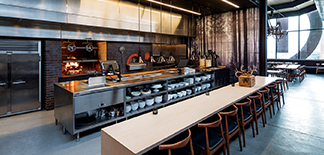As restaurants compete to differentiate their offerings, solid fuel cooking methods are becoming popular to create traffic-driving culinary creations. In fact, menu mentions of “wood-fired” items alone have grown 57% in the past four years (Datassential SNAP!™ 2020). Solid fuel cooking not only refers to burning wood or wood pellets but also includes burning charcoal, briquettes, and mesquite. Cooking with solid fuel allows restaurant operators to offer foods with diverse and intense flavors. Another rising trend, open-concept kitchens, use the dancing flames and smoldering embers to add to the restaurant ambiance and customer experience. For restaurateurs looking to amplify the flavors and experiences they offer with solid fuel cooking, there are crucial considerations when building and maintaining a safe and effective kitchen and ventilation system.
In a commercial kitchen, the ventilation system is comprised of an exhaust hood, exhaust fan, grease duct, make-up air, fire suppression, control centers, and pollution control units in certain applications. When this system serves a solid fuel cooking appliance, there are additional International Mechanical Code (IMC) and the National Fire Protection Agency (NFPA) stipulations for the system and its components. In kitchens with solid fuel cooking, the ventilation system must have a separate exhaust system. Exhaust hoods serving solid fuel appliances must be large enough, in both overhang and air volume, to fully capture and contain all of the cooking effluents, and non-solid fuel appliances cannot be housed under the same hood.
While multiple solid fuel-specific hoods can share grease exhaust ducts, they must exhaust independently of any other exhaust system. Exhaust fans also cannot be wall-mounted, as wall termination of solid fuel exhaust systems is prohibited, per NFPA. For any solid fuel cooking appliance that produces effluent carrying grease, it must be outfitted with a fire suppression system that is rated and designed to extinguish solid fuel cooking fire. The fire suppression system must also be large enough to completely extinguish a solid fuel cooking fire and prevent reignition.
Because solid fuel cooking operations produce more affluent than gas or electric appliances, its ventilation system requires more significant maintenance to ensure efficient and effective functionality over time. In general, exhaust systems must be cleaned prior to the surfaces becoming heavily contaminated with grease build-up. For solid fuel cooking appliances, grease build-up accumulates in the form of creosote which is comprised mostly of tar. Creosote has a flashpoint of approximately 165° F, and it can easily ignite because solid fuel cooking commonly reaches extreme temperatures of 700° F or more.
To prevent this combustible build-up, code dictates stringent inspection and maintenance measures in addition to the foundational maintenance code dictated in NFPA 96 Chapter 11. Commercial cooking systems using solid fuel must have its combustion chamber scraped clean to its original surface on a weekly basis. The flue or chimney must be inspected weekly for residue or corrosion, and overall the entire system must be inspected in full every month.
Designing a functional and safe commercial kitchen has its complicated aspects and selecting the correct ventilation products can significantly impact customer and employee safety. For assistance in designing your kitchen, selecting the correct ventilation products, and abiding by code requirements for solid fuel cooking appliances, get in touch with an Accurex ventilation expert.







